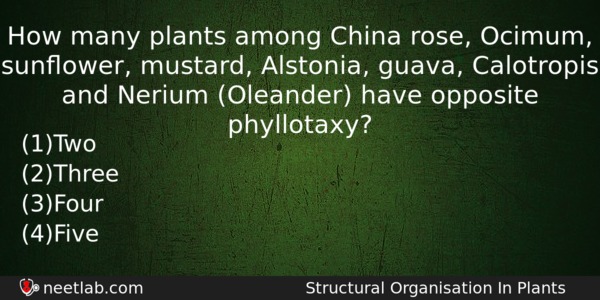| ⇦ | 
| ⇨ |
How many plants among China rose, Ocimum, sunflower, mustard, Alstonia, guava, Calotropis and Nerium (Oleander) have opposite phyllotaxy?
Options
(a) Two
(b) Three
(c) Four
(d) Five
Correct Answer:
Three
Explanation:
Phyllotaxy is the pattern of arrangement of leaves on the stem or branch.
Ocimum, Guava, Calotropis → Opposite phyllotaxy
China rose, Sunflower, Mustard → Alternate phyllotaxy
Alstonia, Nerium (Oleander) → Whorled phyllotaxy
Related Questions: - Largest number of chloroplast is found in
- Gout disorder happens due to accumalation of which joints
- Excessive pulling of ligaments between two bones causes
- Term apply to ribosome is
- Average life span of human RBC is
Topics: Structural Organisation In Plants
(243)
Subject: Biology
(4253)
Important MCQs Based on Medical Entrance Examinations To Improve Your NEET Score
- Largest number of chloroplast is found in
- Gout disorder happens due to accumalation of which joints
- Excessive pulling of ligaments between two bones causes
- Term apply to ribosome is
- Average life span of human RBC is
Topics: Structural Organisation In Plants (243)
Subject: Biology (4253)
Important MCQs Based on Medical Entrance Examinations To Improve Your NEET Score
18000+ students are using NEETLab to improve their score. What about you?
Solve Previous Year MCQs, Mock Tests, Topicwise Practice Tests, Identify Weak Topics, Formula Flash cards and much more is available in NEETLab Android App to improve your NEET score.
Share this page with your friends

Leave a Reply